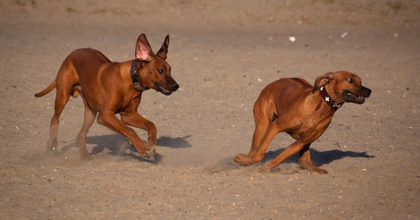
 )
)How’s this for a science experiment? Take your dog for a walk in the woods, let them run around a bit, and have them come back. And that’s it; you’ve scienced! OK, so that’s not really the science part. For that, you add a GPS collar to track the dog’s movement, and you repeat the process with a couple dozen other dogs over hundreds of walks. Then, when you look at all the data from those various jaunts, you might find evidence that the dogs are orienting themselves to the Earth’s magnetic field.
After exploring new territory, dogs have two options for getting back to where they started–assuming they don’t have a human to lead them. They can follow their nose and sniff out the scent of the track they left on the way out, or they can explore and blaze a different route. If they opt for the second approach, how do they know if they are headed in the right direction? From the GPS data, it was observed that dogs tend to run along a north/south line for a bit, and afterwards seem to be able to navigate more directly back to where they started. The hypothesis is that they can sense the magnetic field of the Earth, use that to orient themselves, and then choose a heading to get where they want to go. Other animals seem to have an ability to sense magnetic fields, so perhaps dogs fit into that group as well.
In order for that sort of navigation to work, the dogs also seem to need to be able to keep track of the general direction they were moving in to know which direction will take them (unless I misunderstand how they are meant to be navigating). If they have a running notion of their orientation, I’m not sure why a north/south orienting run would be necessary, but maybe I just need to spend more time wandering in the woods. Some effort was made to rule out navigation relative to the sun and visual navigation, so I’m not sure how else to explain the dogs’ ability to find their way.
And yes, I also thought some of you might just need a video of a dog enjoying doghood.
For those who prefer cats, you can check out this report of a domesticated cat fossil from Kazakhstan dated to over 1,000 years ago. Apparently domestic cats are just as reclusive in death as they are in life, so skeleton finds are rare. Since I associate domesticated cats with ancient Egypt, I was a little surprised that such a relatively recent fossil is the earliest specimen from the region. But I guess I knew cats aren’t for everybody. The paper has some interesting details on the genetics of domestic cats and related wildcats, complete with a 23andMe-style analysis of where this cat may have come from. There’s also some inferences about what the cat ate based on radioactive isotope analysis, and evidence that the cat received treatment for broken bones. Apparently just one cat fossil can spin quite the yarn.
Don’t forget the Emerging Scholars Network / American Scientific Affiliation joint mini-conference for students and early career scientists–this weekend! More details here.
Andy has worn many hats in his life. He knows this is a dreadfully clichéd notion, but since it is also literally true he uses it anyway. Among his current metaphorical hats: husband of one wife, father of two teenagers, reader of science fiction and science fact, enthusiast of contemporary symphonic music, and chief science officer. Previous metaphorical hats include: comp bio postdoc, molecular biology grad student, InterVarsity chapter president (that one came with a literal hat), music store clerk, house painter, and mosquito trapper. Among his more unique literal hats: British bobby, captain’s hats (of varying levels of authenticity) of several specific vessels, a deerstalker from 221B Baker St, and a railroad engineer’s cap. His monthly Science in Review is drawn from his weekly Science Corner posts — Wednesdays, 8am (Eastern) on the Emerging Scholars Network Blog. His book Faith across the Multiverse is available from Hendrickson.

Leave a Reply